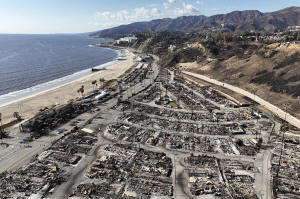Rain douses wildfires in Southern California without causing serious
mudslides
 Send a link to a friend
Send a link to a friend
 [January 28, 2025]
By CHRISTOPHER WEBER [January 28, 2025]
By CHRISTOPHER WEBER
LOS ANGELES (AP) — The first significant storm of the season brought
snow and downpours to Southern California that doused wildfires and
caused some ash and mud to flow across streets in the Los Angeles area
on Monday.
More than an inch (2.5 centimeters) of rain fell in many areas,
loosening Los Angeles hillsides burned bare by the recent blaze near the
Pacific Palisades neighborhood, where crews cleared inundated roadways
including the famed Pacific Coast Highway.
In neighboring Malibu, four schools were closed Monday “due to dangerous
road conditions,” the Santa Monica-Malibu Unified School District said
in a statement.
Clouds were clearing, but flood watches from lingering pockets of rain
were still in effect for fire-scarred areas of the Palisades, Altadena
and Castaic Lake.
“All these fresh burns are very susceptible to rapid runoff,” said Joe
Sirard, a meteorologist for the National Weather Service’s office for
Los Angeles.
North of Los Angeles, snowy conditions late Sunday shut down the
mountainous Tejon Pass section of Interstate 5, a key north-south artery
for the state. It reopened Monday afternoon. The highway rises to more
than 4,100 feet (1,250 meters) between LA and the San Joaquin Valley,
making it susceptible to storm closures.

Mountains across San Bernardino and Riverside counties were under a
winter storm warning Monday and were forecast to get about a foot (0.30
meters) of snow from the storm. Chains were required for some vehicles
heading to ski resorts in the Big Bear Lake area northeast of Los
Angeles because of icy roads.
Parts of San Diego County received more than an inch of rain, while
other areas got less.
The rain began Saturday after months of dry and often gusty weather that
created dangerous fire conditions.
Los Angeles County crews spent much of last week removing vegetation,
shoring up slopes and reinforcing roads in areas devastated by the
Palisades and Eaton fires, which reduced entire neighborhoods to rubble
and ash after breaking out during powerful winds Jan. 7.
[to top of second column]
|

An aerial view shows the devastation left by the Palisades Fire in
the Pacific Palisades section of Los Angeles, Monday, Jan. 27, 2025.
(AP Photo/Jae C. Hong)

The Palisades Fire, the largest of the blazes that destroyed
thousands of homes and killed at least 12 people, reached 94%
containment Monday. The Eaton Fire, which broke out near Altadena
and has killed at least 17 people, was 98% contained.
The Hughes Fire, which ignited north of Los Angeles last week and
caused evacuation orders or warnings for more than 50,000 people,
was nearly contained.
Downpours in San Diego County, helped firefighters make significant
progress against the smaller Border 2 Fire churning through a remote
area of the Otay Mountain Wilderness near the U.S.-Mexico border.
Los Angeles city and county officials last week expedited cleanup
efforts and other measures aimed at mitigating the environmental
impacts of fire-related pollutants, and a White House statement on
Friday said President Donald Trump has directed federal officials to
help local authorities. Within five days of the order, the Federal
Emergency Management Agency and other departments “shall develop and
execute a plan to expedite the bulk removal of contaminated and
general debris,” the statement said.
Officials cautioned that ash in recent burn zones was a toxic mix of
incinerated cars, electronics, batteries, building materials,
paints, furniture and other household items. It contains pesticides,
asbestos, plastics and lead. Residents were urged to wear protective
gear while cleaning up.
Concerns about post-fire debris flows have been especially high
since 2018, when the town of Montecito, up the coast from Los
Angeles, was ravaged by mudslides after a downpour hit mountain
slopes charred by a huge wildfire. Hundreds of homes were damaged
and 23 people died.
The rain ended a near-record streak of dry weather for Southern
California. Most of Southern California is currently in “extreme
drought” or “severe drought,” according to the U.S. Drought Monitor.
All contents © copyright 2025 Associated Press. All rights reserved |